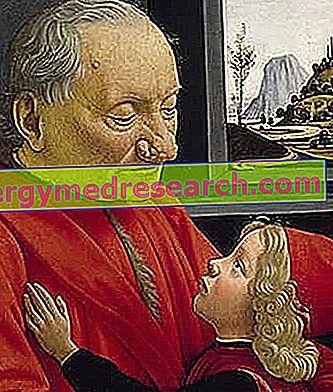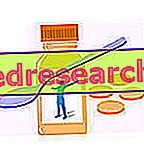By white tongue we mean a condition in which the tongue assumes a whitish color or is covered with a light patina. These two phenomena can be traced to different conditions, sometimes physiological, sometimes pathological.

- Use of particular products for oral hygiene.
- Insufficient dehydration and / or salivation.
- Nutritional deficiencies.
- Hyperventilation from the mouth.
- Food residues and bacterial growth.
- Infections.
- Autoimmune dermatological diseases.
- Mucosal lesions.
What to do
- First of all it is necessary to understand if the white tongue is the result of a normal reaction or if it constitutes a more important clinical sign. The best advice is always to seek medical attention, even if some possible causes can be identified independently.
- Make sure it is not a reaction to a certain type of mouthwash: products containing hydrogen peroxide tend to fade the tongue.
- Treat oral hygiene by cleaning the mouth after meals and avoiding food residues.
- Promote salivation: the lack of saliva is a factor that often causes the white tongue. The increase in salivation can be obtained:
- Chewing gum.
- Drinking / eating products that can increase salivation (see What to Eat below).
- Treating the pathologies or anatomical complications that prevent the nose from being ventilated (rhinitis, adenoids, etc.).
- Keep the oral mucosa moist by sipping a little water from time to time.
- Keep global hydration by drinking enough.
- Treat any pathologies that induce fluid loss (fever, vomiting and diarrhea).
- Limit or compensate for sweating.
- Since the white tongue can be caused by some nutritional deficiencies, it is necessary to guarantee all the recommended rations (especially of vitamins).
- Contact your doctor for research and possible treatment of pathological factors:
- Candida albicans infection (oral candidiasis): it is necessary to take an antifungal drug.
- Chronic inflammatory dermatosis (lichen planus): anti-inflammatory drugs, antihistamines and retinoids.
- Leukoplakia (benign lesion of the oral mucosa): the cure changes according to the causative agent * . It is essential to stop smoking and reduce alcohol. In the rare cases in which it develops in cancer, surgical removal is necessary.
* Chronic trauma, irritation phenomena (edges of decayed or chipped teeth, dental appliances, etc.), nutritional deficiencies, anemia, allergies, infections and immunosuppression.
What NOT to do
- Do not seek medical attention, especially when the white tongue has organic material similar to ricotta, blisters or obvious alterations.
- To be alarmed excessively: it happens especially to mothers who identify tongue clearing in very young children. Often these are non-pathological or easily reversible conditions.
- Neglecting oral hygiene.
- Do not increase salivation in case of dry mouth.
- Do not hydrate the dry mouth.
- Consume foods and drinks that promote global and localized dehydration of the mouth (see What NOT to Eat).
- Excessively sweating without compensating by hydrating the body.
- Take diuretic drugs.
- Neglecting pathologies or anatomical complications that prevent the nose from being ventilated (rhinitis, adenoids, etc.).
- Neglecting any pathologies that favor the loss of fluids (fever, vomiting and diarrhea).
- Ignore any nutritional deficiencies and follow an unbalanced diet.
- If present, do not cure Candida albicans infection.
- If present, do not treat chronic inflammatory dermatosis (lichen planus).
- If present, do not cure leukoplakia:
- Continue to smoke.
- Subject the mucosa to irritation and trauma.
- Suffering from anemia.
- Do not compensate for allergic attacks, infections and immunosuppression.
What to eat
- If the white tongue is caused by the lack of salivation, it can be very useful:
- Chewing gum.
- Drink small sips of lemonade or herbal teas made from medicinal herbs.
- If the white tongue is caused by dehydration it can be very useful:
- Drink frequently.
- Consume foods with good concentrations of water: mainly fresh and unprocessed ones. Fruit and vegetables are particularly suitable.
- If necessary, make use of isotonic drinks.
- If dehydration is induced by vomiting and diarrhea:
- For the acute stages of vomiting, prefer dry foods capable of absorbing digestive juices. Later it will be necessary to increase the concentration of liquids.
- Functional foods for vomiting (eg ginger).
- Consume astringent foods (lemon, unripe bananas, medlar, carob flour and tea).
- Consume foods that do NOT contain significant amounts of fiber (I and II basic food group and refined or peeled vegetables).
- Digestible foods and prepared with suitable cooking systems (drowning or boiling, steaming, vasocottura, in the microwave, in foil, in a pan over medium heat).
- If the white tongue is caused by anemia it can be very useful to consume:
- Foods rich in iron, especially heme and ferrous (2+):
- Muscle tissue: both of terrestrial and aquatic animals: horsemeat, bovine, swine, avian, fish, whole molluscs (also land snails), whole crustaceans etc.
- Eggs: any, especially the yolk.
- Offal and fifth quarter: mainly spleen and liver, but also marrow, diaphragm, heart, etc.
- Foods rich in vitamin C, citric acid and fructose:
- Sweet and sour fruit: lemon, grapefruit, orange, mandarin, clementine, kiwi, cherries, strawberries etc.
- Vegetables and tubers: parsley, pepper, lettuce, spinach, radicchio, broccoli, tomato, potato etc.
- Foods rich in vitamin B12 (cobalamin):
- The same foods source of heme iron.
- Foods rich in folic acid: liver, vegetables (eg tomatoes), sweet fruit (orange, apple, etc.) and legumes (eg beans).
NB : Vitamin C or ascorbic acid and folic acid are thermolabile molecules and degrade with cooking. This means that the foods that contain them must be eaten largely raw.
However, the anti-nutritional principles (phytates and oxalates) are degraded by heat treatment. This means that legumes, whole grains, spinach, rhubarb and so on. should always be consumed after cooking.
- It is believed that a good dose of antioxidants (vitamins, polyphenols and minerals) can counteract the onset of leukoplakia:
- Vitaminics: the antioxidant vitamins are carotenoids (provitamin A), vitamin C and vitamin E. Carotenoids are contained in vegetables and red or orange fruits (apricots, peppers, melons, peaches, carrots, squash, tomatoes, etc.); they are also present in shellfish and milk. Vitamin C is typical of acidulous fruit and some vegetables (lemons, oranges, tangerines, grapefruit, kiwi, peppers, parsley, chicory, lettuce, tomatoes, cabbage, etc.). Vitamin E is available in the lipid portion of many seeds and related oils (wheat germ, maize germ, sesame, kiwi, grape seeds, etc.).
- Minerals: zinc and selenium. The first is mainly contained in: liver, meat, milk and derivatives, some bivalve molluscs (especially oysters). The second is contained above all in: meat, fishery products, egg yolk, milk and dairy products, fortified foods (potatoes, etc.).
- Polyphenols: simple phenols, flavonoids, tannins. They are very rich: vegetables (onion, garlic, citrus fruits, cherries, etc.), fruit and related seeds (pomegranate, grapes, berries, etc.), wine, oilseeds, coffee, tea, cocoa, legumes and whole grains, etc.
What NOT to Eat
- Alcoholic drinks: increase global dehydration, worsen the metabolism of any drugs taken and predispose to leukoplakia.
- Foods rich in sodium: contained in cooking salt, this mineral tends to dehydrate the mucous membranes of the mouth. Avoid foods in salt or in brine, cold cuts, aged cheeses, packaged snacks, etc.
- In case of diarrhea: whole foods, not easily digestible, laxatives, dairy products, containing gluten if the subject is celiac etc.
- In case of vomiting: watery, poorly digestible food, large portions etc.
- In case of anemia:
- Poor or depleted heme and ferrous foods (2+), vitamin C, folic acid and cobalamin.
- With too many fibers.
- With too many tannins.
- Excessively rich in phytates and oxalates.
- Excessively rich in calcium.
Natural Cures and Remedies
Natural remedies against oral candida:
- Plants with adaptogenic / immunostimulatory action that also act at a systemic level: Uncaria ( Uncaria tomentosa ), Echinacea ( Echinacea purpurea ), Curcuma ( Curcuma longa ).
- Rinse with chamomile drink.
Natural remedies against lichen planus:
- Rinses with bicarbonate.
Generic natural remedies:
- Nettalingua: it is an instrument of the Ayurvedic tradition that serves to clean up the surface of the tongue. According to traditional Indian medicine, the white patina is made up of toxins that should be systematically removed to prevent them from being reabsorbed.
- Oil pulling: rinses with edible oil, which should reduce bacterial growth. It should precede the language nectal.
- Rinses with spices and aloe vera juice: they have antibacterial, antifungal, etc. Like the previous one, they should precede the language nectal.
Pharmacological care
Candida medications:
- Azole drugs for systemic use (to be taken by mouth):
- Itraconazole (eg Sporanox, tablets).
- Polyene drugs: excellent pharmacological remedy for the treatment of systemic candidiasis:
- Amphotericin B (eg Abelcet).
- Nystatin (eg. Mycostatin).
- Echinocandins: these drugs act against Candida and Aspergillus infections:
- Cancidas (eg Caspofungin).
- Mycamine (eg. Micafungin).
Drugs for lichen planus:
- Corticosteroids: to be used topically in ointment or systemic tablets; they are able to reduce the associated inflammation. Potential side effects may limit its use for diabetics and other individuals suffering from metabolic disorders.
- Antihistamines: they act as anti-inflammatories.
- Retinoids: to be applied mainly on the spot in the form of ointment. They are synthetic versions of vitamin A that can promote skin regeneration.
Prevention
Prevention of the white tongue is specific based on the causative agent:
- Maintain a good level of oral hygiene: this involves washing the teeth after about 30 'from eating the meal. Some toothbrushes are equipped with appendages designed for tongue cleaning. The mouthwash facilitates the reduction of oral bacterial load but may be responsible for the temporary whitening of the tongue.
- Keep the body well hydrated.
- Avoid dehydration by limiting risky behaviors: excess alcohol, use of diuretics, etc.
- Ensure efficient nasal ventilation: if necessary, take a specific cure for diseases that obstruct the nose or remedy surgically.
- Eat properly and make up for the nutritional deficiencies of: iron, folic acid and vitamin B12.
- Prevent candida infections: this concerns global hygiene and the prevention of venereal diseases and the related infection. Furthermore, it would be desirable for the mother to avoid contracting the vaginal candida during pregnancy or just before, in order to avoid contagion to the unborn child during birth.
- Prevent lichen planus as much as possible. They can be related:
- Hepatitis C: in this case, lichen planus is of secondary importance.
- Allergens: if the analyzes recognize the sensitivity to some allergens, it is possible that limiting the exposure to them can reduce the incidence of liche planus.
- Drugs: Your doctor may link the occurrence of lichen planus to taking a certain drug that will immediately stop.
- Prevent leukoplakia as much as possible. They can be related:
- Avoid tobacco and especially smoking.
- Avoid or minimize ethyl alcohol.
- Increase the intake of antioxidants in the diet.
Medical Treatments
- Surgery: affects the white tongue on two very distinct fronts.
- Adenoidectomy, septoplasty, turbinate reduction: removal / remodeling of various structures to allow nasal ventilation and reduce dry mouth.
- Removal of leukoplakia evolved into a tumor.



